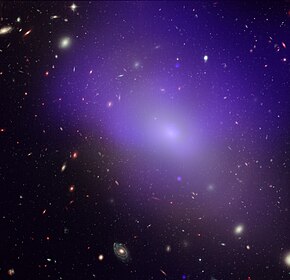| NGC 1132 | |
|---|---|
 A visible light image of NGS1132 with X-ray emission superimposed (rendered in blue) | |
| Observation data (J2000 epoch) | |
| Constellation | Eridanus |
| Right ascension | 02h 52m 51.82s[1] |
| Declination | −01° 16′ 29.0″[1] |
| Redshift | 6871 km/s[2] |
| Heliocentric radial velocity | 0.023189[2] |
| Distance | 263.9 Mly (80.91 Mpc)[3] |
| Apparent magnitude (B) | 13.9[2] |
| Characteristics | |
| Type | E[2] |
| Other designations | |
| UGC 2359, MCG +00-08-040, PGC 10891[2] | |
NGC 1132 is an elliptical galaxy located in the constellation Eridanus.[4] The galaxy was discovered by John Herschel on November 23, 1827.[5] It is located at a distance of about 318 million light-years away from Earth.[6]
NGC 1132 and nearby small galaxies are known as a "fossil group" that resulted from the merger of a group of galaxies.[4] It is the prototype example of the class of fossil galaxy groups.[7] The identification as a fossil group was made in 1999.[8] This group contains an enormous amount of dark matter and a large amount of hot gas that emits X-ray radiation.[9] The galaxy is surrounded by thousands of globular star clusters.[10]
One supernova has been observed in NGC 1132: SN 2024pbe (type Ia, mag. 17.8).[11]

- ^ a b Cutri, Roc M.; Skrutskie, Michael F.; Van Dyk, Schuyler D.; Beichman, Charles A.; Carpenter, John M.; Chester, Thomas; Cambresy, Laurent; Evans, Tracey E.; Fowler, John W.; Gizis, John E.; Howard, Elizabeth V.; Huchra, John P.; Jarrett, Thomas H.; Kopan, Eugene L.; Kirkpatrick, J. Davy; Light, Robert M.; Marsh, Kenneth A.; McCallon, Howard L.; Schneider, Stephen E.; Stiening, Rae; Sykes, Matthew J.; Weinberg, Martin D.; Wheaton, William A.; Wheelock, Sherry L.; Zacarias, N. (2003). "VizieR Online Data Catalog: 2MASS All-Sky Catalog of Point Sources (Cutri+ 2003)". CDS/ADC Collection of Electronic Catalogues. 2246: II/246. Bibcode:2003yCat.2246....0C.
- ^ a b c d e "NGC 1132". Simbad. Université de Strasbourg/CNRS. Retrieved September 24, 2020.
- ^ Tully, R. Brent; Courtois, Hélène M.; Sorce, Jenny G. (2016). "Cosmicflows-3". The Astronomical Journal. 152 (2): 21. arXiv:1605.01765. Bibcode:2016AJ....152...50T. doi:10.3847/0004-6256/152/2/50. S2CID 250737862. 50.
- ^ a b Cite error: The named reference
HSTwas invoked but never defined (see the help page). - ^ "New General Catalog Objects: NGC 1100 - 1149". cseligman.com. Retrieved 2020-09-25.
- ^ Cite error: The named reference
physwas invoked but never defined (see the help page). - ^ Cite error: The named reference
fossilwas invoked but never defined (see the help page). - ^ Cite error: The named reference
Jewelswas invoked but never defined (see the help page). - ^ Cite error: The named reference
Chandrawas invoked but never defined (see the help page). - ^ Cite error: The named reference
ESAwas invoked but never defined (see the help page). - ^ Transient Name Server entry for SN 2024pbe. Retrieved 11 July 2024.